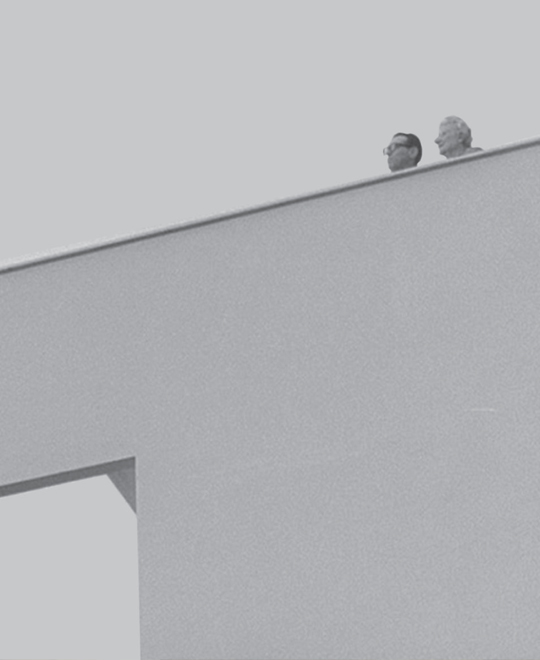Studio 25
Studio 35 mm: Film, Architecture and the Species of Spaces
Hamid Khalili & AnnMarie Brennan

Studio Description
Sigfried Giedion, the prominent architectural theorist remarked: “Only film can make the new architecture intelligible.” The task of making architecture ‘intelligible’ rests in the core of this design studio. Traditional architectural media such as plans and sections stutter when it comes to successfully articulating architectural ATMOSPHERES and the ethos of spaces that are beyond matters such as form, function and technicality. This studio interrogates the medium of film as a means to make ‘intelligible’ the qualities that traditional orthographic drawings are unable to do; underlying notions such as atmosphere, mood, ambiance, spatial experience and milieu.
This studio seeks to provide students with appropriate methods, tools and skills to learn the cinematic strategies for narrating atmospheres and qualities associated with architectural spaces. What will be offered in the studio becomes a matrix of synthesis for each student with research into film, film and architectural theory, weekly active filming and editing exercises and, most importantly, applying filmic techniques within an architectural context. We will harness the power of filmic tools to comprehend, dissect, communicate and design architectural atmospheres. Studio 35mm attempts to create an opportunity for focusing on the rarely examined fundaments of architecture - species of spaces* such as doors, windows, staircases, hallways, columns, balconies, corridors, passageways, openings, thresholds, living rooms, dining tables, kitchens, laneways, bedrooms, lifts, ceilings, and ramps; their meaning, atmospheric qualities and ambiances through short films, animations, hybrid moving images and VR.
Studio Outcomes
At the end of this subject students will be able to:
- Re-discover, examine and dissect the theories related to a species of spaces from a phenomenological and experiential perspective.
- Articulate the architectural theme ‘atmosphere’ through various media and design techniques.
- Test how the species of spaces are used, inhabited and experienced by users.
- Use and apply tools, techniques and knowledge of photography and cinematography within architectural context.
- Use and apply theoretical and practical aspects of film editing and montage in architectural design and architectural time-based media.
- Engage with the realms of theory and philosophy where film and similar media, overlap and influence the way architecture is perceived and experienced.
- Plan and make a film, animation, and VR for communicating spatial qualities of architectural/urban spaces in a compelling and professional way.
- Examine architectural/urban spaces in/through film and investigate film as means of architectural documentation and historiography.
- Engage with film as a source of formal, theoretical, historical and socio-spatial inspiration.
- Put forward design proposals based on cinematic analyses.
- Explore cinematic qualities of architectural/urban spaces.
This studio is structured around three parts. For each part, students will make a film, animation, VR or AR. The products are supported by sophisticated exploratory and descriptive diagrams, plans, physical models, conceptual sculptures, choreographic mapping, image-space analysis and other techniques that architects and, sometimes, filmmakers use.
Studio Leaders
HAMID KHALILI is a PhD researcher and design studio leader in the Faculty of Architecture, Building, and Planning at the University of Melbourne. Hamid’s doctorate focuses on the cine-spatial strategies adopted in the films of two internationally acclaimed filmmakers, Bela Tarr and Theo Angelopoulos. Apart from his theoretical studies into film and architectural theory, Hamid has practiced both design and film (as editor, cinematographer, animator and VFX designer) in Europe and the Middle East. He has taught design studios at MSD and has been involved, as a studio leader and guest lecturer, in various design studios and theoretical subjects engaging with the reciprocity between cinema and architecture in Europe, Australia, and Iran.
ANNMARIE BRENNAN is a Senior Lecturer of Design Theory in the Faculty of Architecture, Building, and Planning at the University of Melbourne. She teaches architectural history, theory and design studio subjects and supervises PhD candidates. Her research focuses on the history and theory of 20th and 21st century design and architecture, with focused interests into the topics of media studies and architecture, the political economy of design, machine culture, design utopias and fictions, the history of systems theory and computing in design.
Reading & Reference
- AlSayyad, Nezar. 2006. Cinematic Urbanism: a History of the Modern from Reel to Real: New York ; London : Routledge, c2006.
- Benjamin, Walter. 2008. The Work of Art in the Age of Mechanical Reproduction. Translated by J. A. Underwood. London: Penguin.
- Bordwell, David Jay, and Kristin Thompson. 2010. Film Art : an Introduction. New York: McGraw-Hill.
- Bruno, Giuliana. 2002. Atlas of Emotion: Journeys in Art, Architecture, and Film. New York: Verso, 2002.
- Cairns, Graham, François Penz, and Holly Rose. 2013. The Architecture of the Screen: Essays in Cinematographic Space. Bristol, England ; Chicago, Illinois : Intellect, 2013.
- Deleuze, Gilles. 1989. Cinema 2: the Time-image. Minneapolis: University of Minneapolis Press, 1989.
- Katz, Steven. 2004. Cinematic Motion: a Workshop for Staging Scenes. Studio City, CA: Michael Wiese Productions.
- Koeck, Richard. 2012. Cine-scapes Cinematic Spaces in Architecture and Cities. Hoboken: Taylor and Francis,.
- Pallasmaa, Juhani. 2007. The Architecture of Image: Existential Space in Cinema. Helsinki: Rakennustieto, 2007.
- Penz, François. 2017. Cinematic-Aided Design: An Everyday Life Approach to Architecture. New York: Routledge.
- Perec, Georges. 2008. Species of space and other pieces. New York: Penguin.
- Tawa, Michael. 2011. Agencies of the Frame: Tectonic Strategies in Cinema and Architecture. Newcastle upon Tyne, UK: Cambridge Scholars Publishing , 2011.
- Thomas, Maureen, and François Penz. 2003. Architectures of Illusion: from Motion Pictures to Navigable Interactive Environments: Bristol ; Portland, OR : Intellect, 2003.
ST1/25 Mondays 09:00-12:00 in MSD Room 118
ST2/25 Wednesdays 12:00-15:00 in MSD Room 228
Need enrolment assistance?
Stop 1 provides enrolment and other support to Bachelor of Design, Bachelor of Environments and Melbourne School of Design students.